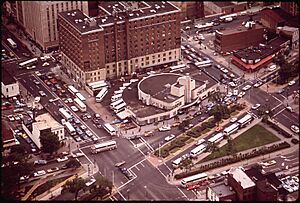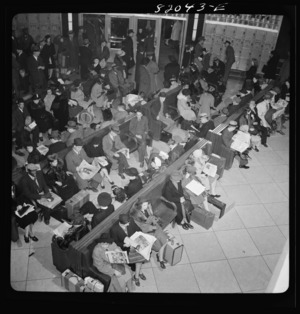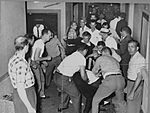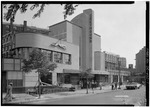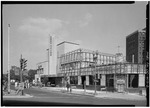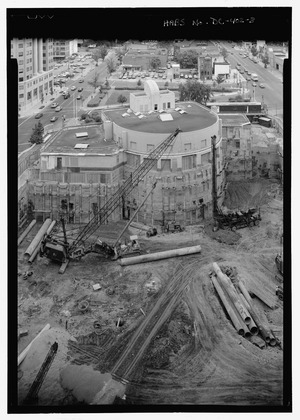Old Greyhound Terminal (Washington, D.C.) facts for kids
Quick facts for kids Old Greyhound Terminal |
|
|---|---|
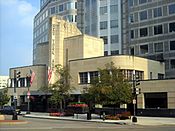 |
|
| General information | |
| Type | Bus Terminal |
| Location | Washington, D.C., United States |
| Coordinates | 38°54′02″N 77°01′39″W / 38.90056°N 77.02750°W |
| Construction started | 1939 |
| Completed | 1940 |
| Technical details | |
| Floor count | 3 |
| Design and construction | |
| Architect | William S. Arrasmith |
The Old Greyhound Terminal was a busy bus station in Washington, D.C.. It served Greyhound Lines buses from 1940 until the 1980s. This building was very important during World War II, helping to move soldiers and sailors. It also played a small but important part in the Civil Rights Movement. Later, people who wanted to save old buildings helped protect it. Today, most of the old bus terminal is part of a new office building called 1100 New York Avenue, which was built in 1991.
Contents
Why a New Bus Station Was Needed
In September 1932, there was a meeting about building a new bus station for Greyhound Lines. The first station was at 1403-11 New York Avenue NW. It opened in June 1933. However, by 1938, this station was too small. So many buses and people used it that a bigger, newer terminal was clearly needed.
Building a Modern Bus Terminal
Plans for a brand new bus station were announced in December 1938. It was expected to cost about $750,000. Construction began in April 1939. The goal was to finish by November 1939. This new station would be air-conditioned and serve several Greyhound bus lines. The land where it was built used to be a railway station that closed in 1935.
The architects for the new terminal were Wischmeyer, Arrasmith & Elswick, along with Frances P. Sullivan. On March 25, 1940, the new Greyhound Lines Terminal officially opened at 1100 New York Avenue NW. This was Greyhound's main station at the time. The building and land cost $1 million. William S. Arrasmith, who designed over 50 modern bus stations, was the main architect. The public was invited to a grand opening party with entertainment and souvenirs.
Inside the Greyhound Terminal
The building was made of strong steel and cement. Its outside was covered with light-colored Indiana limestone. Black trim and glass blocks made the entrance look modern. The main entrance was on New York Avenue NW. It led into a lobby and then to the large waiting room.
Inside the waiting room, there were eight ticket windows for quick service. The room was air-conditioned and decorated with wood and shiny copper. The floor had a cool checkerboard pattern. Pictures of beautiful places in the United States decorated the walls. The domed ceiling was painted in soft colors. Also on this floor, visitors could find a travel agency, baggage checkrooms, phone booths, an information desk, a restaurant, and a large drug store.
Behind the waiting area were thirteen covered spots for buses to load and unload. There were also twenty extra parking spots for buses and a taxi stand. Downstairs, there were restrooms and storage rooms for the restaurant. On the second floor were the Greyhound offices, where people managed calls, accounting, and bus schedules.
Busy Early Years
On March 26, 1940, the first bus arrived at the new terminal. All buses from Greyhound Lines, Peninsula Bus Company, and Blue Ridge Bus Company used this station. Buses entered from 11th Street NW and left on 12th Street NW.
In its first few years, the station was extremely busy. This was because of World War II. Many soldiers, sailors, and airmen traveled across the country. Greyhound Lines played a big part in the war effort, especially since gas and rubber were limited for cars.
The Freedom Ride of 1961
The Old Greyhound Terminal was the starting point for an important event called the Freedom Ride 1961. On May 4, 1961, thirteen brave people, both black and white, boarded buses in Washington, D.C. Some boarded a Trailways bus, and others boarded a Greyhound bus from this terminal. They began a two-week trip through several Southern states. Their goal was to reach New Orleans, Louisiana.
This trip was called the "Freedom Ride 1961" and was organized by the Congress of Racial Equality (CORE). It was inspired by an earlier trip in 1947. The Freedom Riders wanted to test if Southern states were following the law. The Supreme Court of the United States had ruled that separating people by race on public buses was against the law. But many Southern states ignored these rules, and the government didn't enforce them.
The Freedom Riders had a plan: at least one mixed-race pair would sit together. Also, at least one black rider would sit in the front of the bus, where only white people were allowed to sit in the South. Other riders would sit throughout the bus. One person would follow the local segregation rules to avoid arrest. This person would then contact CORE to arrange bail for anyone who was arrested.
The volunteers left Washington, D.C., without problems. They faced small issues in Virginia and North Carolina. John Lewis was even attacked in South Carolina. However, in Anniston and Birmingham, Alabama, there was terrible violence. With help from local police, the Ku Klux Klan attacked the groups. The Greyhound bus was even firebombed, and both groups were beaten. This brave trip was a very important part of the Civil Rights Movement.
Changes and Moving On
In the summer of 1974, the city told Greyhound Lines to clean the bus station's bathrooms. An inspection found many problems, like flies, roaches, and broken toilets. The company was given time to fix everything.
In 1976, Greyhound Lines decided to update the building. They wanted it to look more modern. Architect Gordon Holmquist was hired for the job. The plan was to cover the old Art Deco style building with new concrete panels and a metal roof. This remodeling cost $1 million.
By 1978, it was clear the terminal was getting old. Its design wasn't working well for so many people. Also, crime was a problem in the area. It seemed like bus stations should be closer to the train station.
In June 1981, Greyhound Lines announced a big plan. They would trade their old station for a new one. A developer named Morton Bender would build a new terminal near Union Station. In return, he would get the old terminal. The old location was very valuable. The new terminal would be twice as big. It was hoped the new station would be ready by the end of 1982.
Another bus company, Trailways, also moved closer to Union Station. Their old terminal had been next to Greyhound's since the 1950s.
Saving a Historic Building
By 1987, a company called Carlyle Associates owned the old building and land. They wanted to build a 12-story building there, which meant tearing down the old Art Deco bus station. The 1940s design was still hidden under the panels from the 1976 remodel. People who wanted to save old buildings worked hard to get the terminal named a historic landmark. This would protect it from being torn down.
On January 24, 1987, the D.C. Historic Preservation Review Board voted to make the old Greyhound Terminal a historical landmark. This was a big decision because the old design was still covered up, and no one knew for sure what condition it was in. It was the first time such a decision was made, setting an example for saving historic buildings across the United States.
In 1988, the developers agreed to make their new office building a bit smaller. This allowed the entire old terminal to be saved. It would become the entrance and lobby of the new 1100 New York Ave office building.
On February 1, 1989, the 1976 panels were finally removed. Everyone was happy to see that the beautiful Art Deco details were still there, including two flagpoles on the front! The whole building was restored. The new 12-floor office building was finished in 1991. It was built where the bus docks and parking used to be, right behind the old waiting area. The "Greyhound" name and logo were replaced with "1100 New York Ave," but the clock remained. Today, a small display about old buses is in the north lobby.
Images for kids


